Michelle Hegyi’s new show, ‘I’ve Never Seen So Many Rainbows’, is a burst of spring in the gallery after a long Michigan winter. Visitors to the gallery will find themselves standing straighter, breathing deeper and smiling….maybe ever uttering a delighted, “Ahhh’.
I had the opportunity to ask her about her work in the show recently. The interview follows:
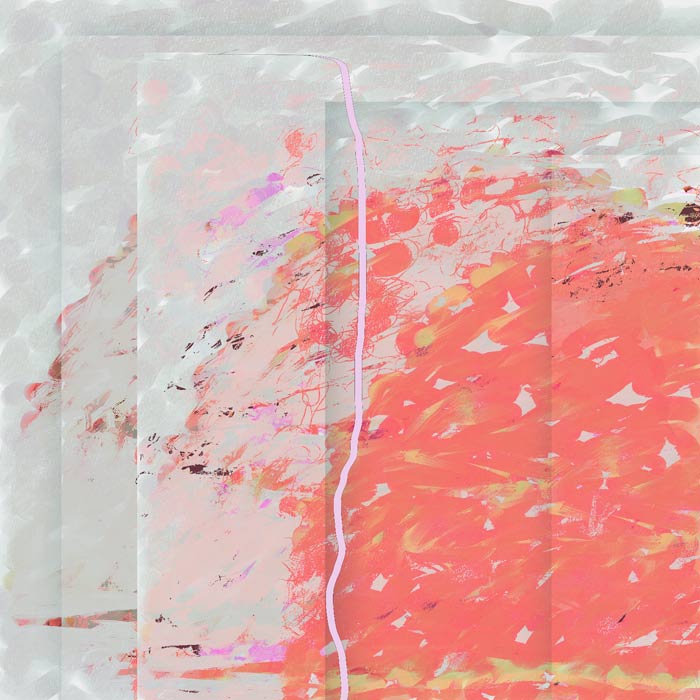
Look Between the Rain (Rainbow Series), No. 2
1/10
pigment ink on rag paper
edition of 10
framed 32″h x 32″w
VM: How has your working process changed from when you first started using digital techniques to create your pieces?
MH: It has changed tremendously.
I started in 1973 to create my first piece of “digital art” using punch cards to write my own software which I ran on a room size computer several miles away. I created the output by painting with real traditional paints, with the location, size, angles, color, and lines of the objects in the painting determined by the data output from my software. I then progressed to a personal computer in 1984 (the first Macintosh) using MacPaint software and a mouse with output on a personal dot-matrix black and white printer on bond paper. In the early 90’s I progressed to using a 24” wide dye based inkjet printer, whose colors would fade, and also experimenting with different substrates such as mylar for printing at that time — which inspired me to start painting with acrylic on mylar which I loved! New archival pigment inks came out a few years later and I began printing with those. When combined with archival papers, e.g. heavyweight Hahnemuhle Photo 100% cotton rag paper, the papers and ink combinations were archival and would last several times longer (now about 200 years) than traditional photographs on photographic papers. I would use Painter software (from Fractal Design, Metacreations, and eventually Corel) with a tablet and pressure sensitive pen, so that I could paint by hand with natural media on the computer — so much more nuanced than painting with only a mouse! And I began using the very first version of Adobe Photoshop to adjust layers and transparencies of my Painter files.
The most challenging aspect was getting the colors right — I struggled for years to get the colors in the print to match the colors in the image I saw on my monitor, especially since color was so important to me. Luckily my husband is a physicist — and he and a computer color scientist friend recommended getting a device to calibrate my monitor and to profile my inks and papers, which had just come out for personal use around 2003. I finally was able to get the colors right and I could experiment using different papers, e.g. Japanese papers that I’ve used with encaustic, and still get the colors to work. And with a calibrated monitor, I could now use Adobe Lightroom to adjust colors perfectly.
In the last couple of years with the introduction of Apple’s iPad Pro with pressure sensitive Apple Pencil, I am able to paint directly on the iPad using the app Procreate. I then bring it into Photoshop and Lightroom on my computer with the calibrated monitor to adjust the layers, opacities, transparencies, color, and to mix it with layers from other files.
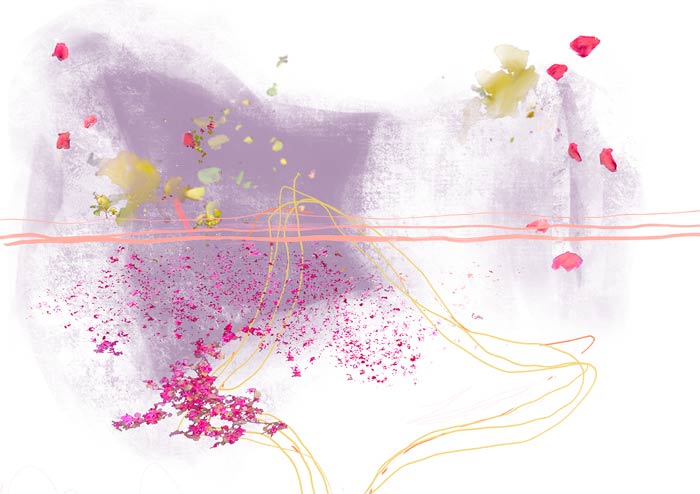
I’ve Never Seen So Many Rainbows 1, pigment ink on rag paper
edition of 10
framed 26.5”h x 36.5”w
2. You first started with more traditional painting media decades ago. How do you think that affected your approach using digital media and vice versa?
I have been painting and drawing with traditional media since I was little. I have always loved the layering, and erasures and the history of a piece, and so I try to include that in my digital work as well.
3. Was there a point in your art-making life where you started to analyze paintings in museums/galleries in a new way, because of your digital working mode?
Oh yes, definitely. My experience creating work digitally has taught me so much about color, light, composition, line and form. For example, in my piece I’ve never seen so many rainbows, No. 4 in this show, I must have moved some of those floating pink buds and yellow orange dashes around at least 50 times till I got it to a point I was happy. Not sure if that was an advantage or a disadvantage!
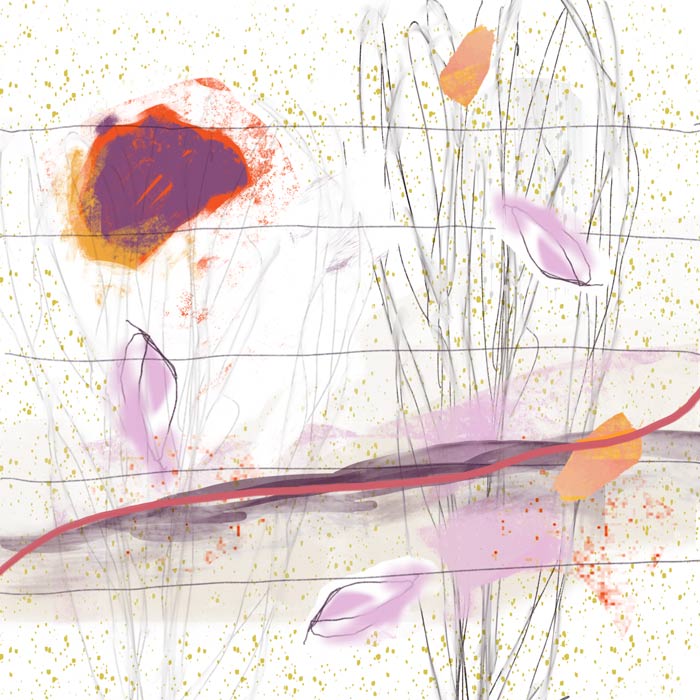
I’ve never seen so many rainbows…, No. 4
1/10
pigment ink on rag paper
edition of 10
framed 32″h x 32″w
4. Your last show at WSG, “Wild Forest’, was much more neutral in color than this show. Can you speak a bit about your use of color this time?
I used to use a lot of blues, yellow greens and lemon yellows. I began to use a yellow orange a few years ago after marveling at the yellow orange California poppies I would see on my many visits to California. Then while in California this last time, I happened to get a good deal on a package of passion fruit, and when I cut one in half I just marveled at the beauty of it, especially of the colors, the deep purple skin with a line of magenta and salmon inside (warm and cool of the same color, always a favorite of mine!) followed by a creamy white line, and then filled with a bowl of olive yellowish green seeds. My piece I’ve never seen so many rainbows, No. 4 actually has a silhouette of a cut open wrinkled passion fruit in the upper left corner.
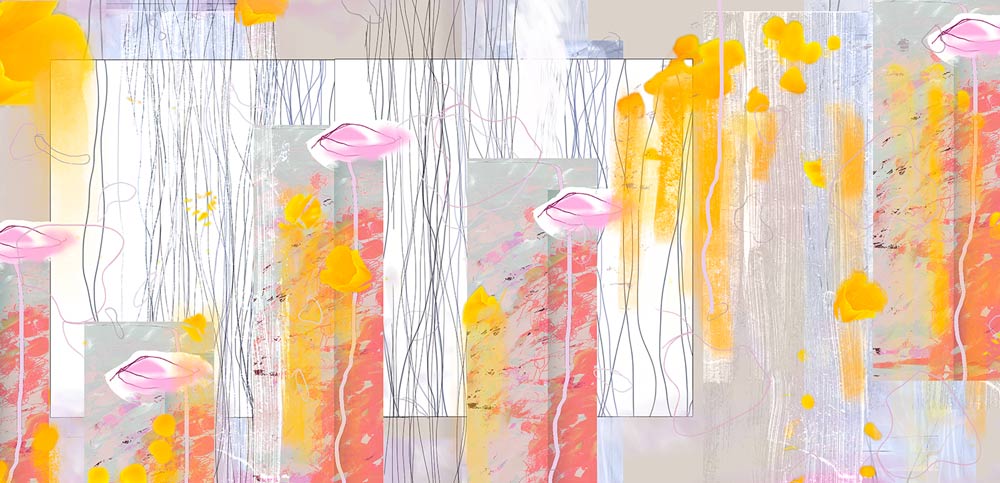
I’ve Never Seen So Many Rainbows 2, 30 x 62″, pigment ink on rag paper
5. You have a HUGE piece in this show. What are the logistics of printing, handling and framing a piece that large?
This is actually the largest piece I have ever printed (although theoretically I could print even larger on my 44” wide Epson 9800 printer — just that the framing would be that much more expensive). I was not sure I would be able to handle it myself as the piece is taller than I am. It’s printed on a roll of heavyweight rag paper as are my other pieces in this show, and so when they come out of the printer they all roll back into a cylinder. I found I could just roll each short edge backward halfway over a roller, and then the piece would lay almost flat, especially once in a frame. I also need to be sure the digital file has enough resolution to be “up-sampled” to be able to print it that large without artifacts. Also one hopes there are no glitches such as a clogged nozzle while printing or I would have to print the whole thing again. Once I’ve flattened the print, I cut it myself leaving about a one inch white border to fit perfectly into the frame since I do not use a mat when framing. I also don’t want to make a mistake at this point or again I would have to re-print it. Now I had to figure out how to get this into the frame myself as it would have a slight curl at the edges so it was difficult to get in all at once. I left this piece till the end to frame since it was so huge, and managed to find a spot on the floor in a roomful of windows where it would fit. I was just beginning to try to place it in the frame when I got an emergency alert on my phone to take shelter immediately, especially away from windows, because of a serious tornado heading my way! It was too big to move with the frame taken apart, so I just had to leave it there and hope for the best.
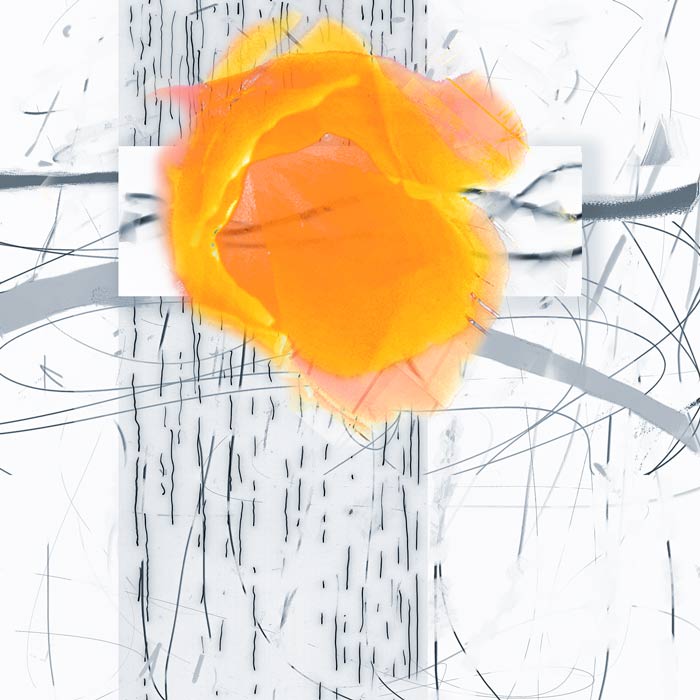
I’ve never seen so many rainbows…, No. 5
1/10
pigment ink on rag paper
edition of 10
framed 32″h x 32″w
6. Lastly, do you have any special studio rituals that help you get in the zone? Music you listen to….sketching, going on a walk?
I do.
On the computer I will look at layers of images from my previous work, and sometimes incorporate some of those, especially since it’s much easier for me to not start from a blank slate. I feel it also unifies my work. I also really enjoy searching for work by other artists that inspires me, and if I’m doing that online, I will save it in a collection of mine using the Flipboard application.
But my favorite is to take walks outside in nature as meditation, as time to think, and for inspiration. Unfortunately, sometimes I get so inspired by what I see that I have to stop every few minutes and take a photo. Luckily my phone I had been using recently did not have a healthy battery, and after a few photos in cold weather it would not work anymore, so then I could continue on my meditative walk without interruption!




